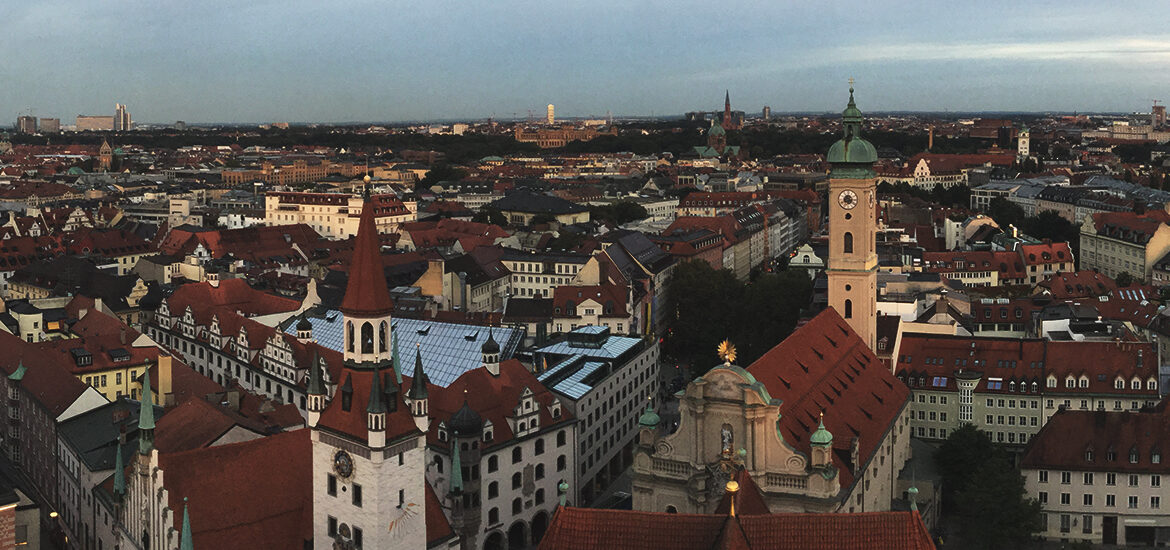September 28, 2016. After Oktoberfest we decided to explore the center of Munich. We didn’t have time for visiting every church and every significant place in the Munich but what I saw it was a miracle.
Our journey through Munich’s bustling streets began with the awe-inspiring sight of the Justizpalast, a majestic Neo-Baroque masterpiece that stood as a testament to German architectural prowess. Each intricately carved detail seemed to whisper secrets of centuries past, drawing us deeper into the city’s rich tapestry. But our adventure had only just begun. Passing through the ancient Karlstor, a relic of medieval fortifications, we entered the city center with eager anticipation. Once a formidable defensive bastion, the gate now stood as a silent sentinel, its current form a mere echo of its former glory. Yet, despite the passage of time, its towering presence still commanded respect, guiding us towards the heart of Munich’s bustling streets. And we made our way along Neuhauser Straße, the heartbeat of Munich pulsed beneath our feet. Here, amidst the bustling throngs of locals and tourists alike, we felt the city’s pulse quicken with every step, beckoning us to explore its hidden treasures.
The first marvel to greet our eyes was the Brunnenbuberl fountain—an enchanting tableau depicting a faun gracefully pouring water over a delighted boy. Crafted by a master artisan, this fountain earned its creator a prestigious silver medal from the Bavarian Academy of Fine Arts, igniting a demand for replicas. Standing before this artistic masterpiece, I couldn’t help but be captivated by its whimsical charm, lingering for five precious minutes to soak in its beauty and wonder.
After our enchanting encounter with the fountain, we found ourselves drawn into the hallowed halls of Bürgersaal. Despite any reservations one might have about visiting religious sites, I assure you, Roman Catholic Churches are akin to living museums—repositories of history and culture that beg exploration. Though the exterior of Bürgersaal may not have held much allure, its interior proved to be a sanctuary of faith and inspiration.
As I wandered through its sacred chambers, I stumbled upon a staircase leading to a hidden gem—a small museum nestled within the lower floors. Intrigued, I pressed a button on a nearby television, and to my delight, was treated to a fascinating tale of courage and conviction. The story centered around Rupert Mayer, a priest whose unwavering resistance against Hitler’s oppressive regime earned him a place in Munich’s pantheon of heroes. From his multiple imprisonments to his eventual refuge in a monastery, Mayer’s indomitable spirit served as a beacon of hope in dark times.
Moving on to the church of St. Michael, I couldn’t help but marvel at its facade, which bore more resemblance to a medieval town hall than a place of worship. Yet, it was precisely this juxtaposition of architectural styles that lent the church its unique charm. And as I stood in its shadow, I couldn’t help but ponder the legends and stories that lurked within its ancient walls—a reminder that every church, no matter its size or grandeur, has a tale to tell.
Ah, the Frauenkirche—a towering marvel that casts its shadow over the city of Munich, beckoning travelers from far and wide to marvel at its grandeur. As I stood before its imposing facade, I couldn’t help but be awestruck by its sheer size—it’s said to accommodate up to 4,000 worshippers, a testament to its monumental scale. Yet, what truly captured my imagination were the legends that shrouded this ancient edifice.
Chief among them was the tale of the Teufelstritt—the Devil’s Footstep—a curious mark left at the church’s entrance. According to legend, the devil himself struck a deal with the builder, offering to finance the construction on the condition that the church contain no windows. Clever as he was, the builder outwitted the devil by positioning columns in such a way that the windows remained hidden from view. When the devil realized he had been tricked, he could only stamp his foot in frustration, leaving behind a dark footprint that remains to this day.
As I approached the entrance, I was met with a lattice barrier, preventing me from getting too close to the infamous footprint. Whether it was out of reverence for the legend or simply for practical reasons, I couldn’t say. But the mystery only added to the allure of the Frauenkirche, reminding me that sometimes, the most fascinating tales are the ones that remain just out of reach.
With our hearts still abuzz from the wonders of the Frauenkirche, we embarked on our next adventure: a journey to St. Peter’s Church. Unlike typical viewpoints that leave me feeling disoriented and disconnected, this one promised a different experience altogether. Perched above buildings, it offered a glimpse into a world that felt straight out of a medieval fairy tale.
As we ascended to the viewing platform, the city stretched out before us like a sprawling tapestry, each rooftop and cobblestone street weaving a story of its own. And as the sun dipped below the horizon, casting its golden glow upon the ancient spires, we couldn’t help but be swept away by the magic of the moment.
With our spirits soaring, we bid farewell to Munich, our hearts brimming with memories of a city steeped in history and charm. And as we turned our sights towards Austria, we knew that our journey was far from over. But for now, it was time to rest and recharge, for tomorrow held new adventures and new stories waiting to be told.
